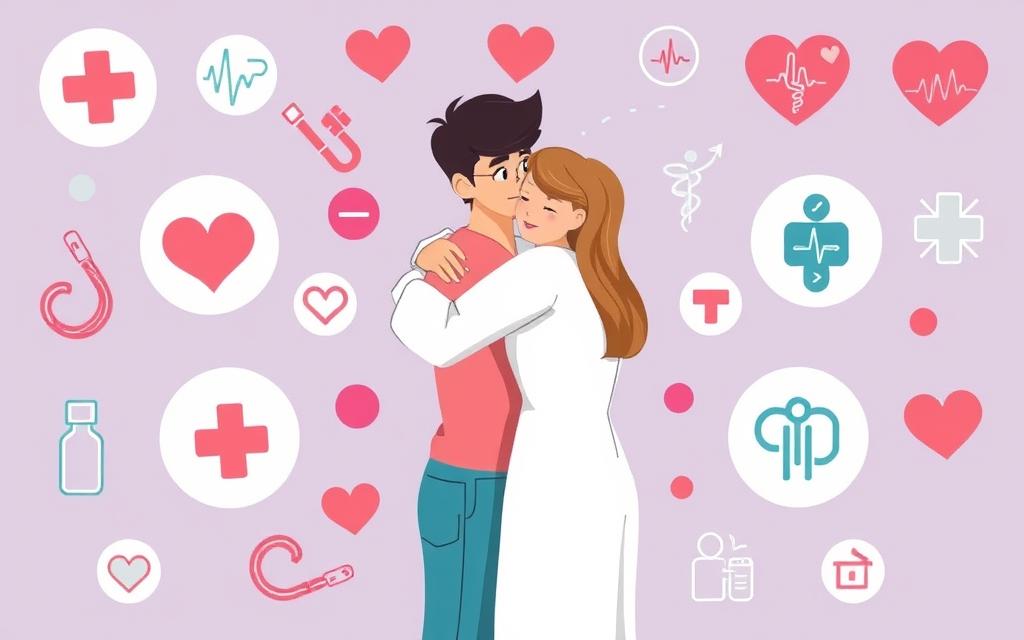Mental Health Awareness Colors and its Impact
Colors significantly influence our moods and emotions, playing a crucial role in various aspects of our lives, including mental well-being. The green ribbon is an internationally recognized symbol associated with mental health awareness color, specifically signifying depression awareness.

Wearing the green ribbon shows support for people with depression. It helps start honest talks and fights stigma. Knowing what mental health colors mean encourages more open conversations. This helps reduce shame around mental illness.
Key Takeaways
- The green ribbon is a powerful symbol for promoting understanding and support for individuals facing mental health challenges.
- Colors have a profound impact on our emotions and mental well-being.
- Mental Health Awareness Hoodie: Comfort and Compassion
- Understanding the symbolism behind mental health awareness colors fosters conversations about mental illness.
- Raising awareness about mental health issues helps reduce stigma.
- Mental health awareness colors serve as visual symbols in the global effort to promote mental health advocacy.
The Significance of Green in Mental Health Awareness
In the context of mental health awareness, green is more than just a color; it’s a symbol of life and recovery. Green has emerged as the primary color for mental health awareness due to its strong associations with nature, growth, renewal, and hope. This makes it an ideal symbol for recovery and healing in mental health contexts.
Symbolism of Green
The symbolism of green in mental health awareness represents the journey from darkness to light that many individuals with mental illness experience during their recovery process. Green stands for balance and peace. These are key for good mental health and helping others. In mental health campaigns, green sends a message of hope. It also helps people recognize and talk about mental health struggles.
The Mental Health Flag
The Mental Health Flag, featuring different shades of green to yellow, signifies a personal journey from darkness to happiness, as well as collective efforts to bring the topic of mental health into the light. The flag incorporates various shades of green and yellow to visually represent the personal journey from struggle to wellness, serving as a powerful emblem for mental health advocacy. By using green, the flag symbolizes the potential for recovery and healing, inspiring hope in those affected by mental health issues.
The Green Ribbon: A Symbol of Support
In the realm of mental health, the green ribbon stands as a powerful emblem of solidarity and understanding. It symbolizes a commitment to supporting individuals facing mental health challenges and fostering an environment that encourages open conversations about mental health issues.
Origins and Meaning
The green ribbon campaign, which emerged in the 1990s, aimed to encourage discussions about mental health and reduce the stigma associated with mental illness. By wearing or displaying the green ribbon, individuals demonstrate their support for those affected by mental health conditions and their commitment to creating a more compassionate and inclusive environment.
The color green, closely associated with nature, represents renewal, growth, and recovery in the context of mental health. This symbolism is crucial as it highlights the potential for personal growth and healing that is central to mental health awareness efforts.
Depression Awareness Connection
The green ribbon is specifically linked to depression awareness, one of the most common mental health conditions worldwide. By signifying depression awareness, the green ribbon encourages open conversations about this condition and promotes a deeper understanding of the challenges faced by those affected.
Wearing a green ribbon is a visible demonstration of one’s commitment to reducing the stigma surrounding mental illness and supporting individuals facing mental health challenges. It underscores the importance of recognizing and addressing depression, a condition that impacts millions of lives globally.
Impact of Colors on Mental Well-being
The impact of colors on our mental well-being is a complex interplay of psychology, biology, and emotional response. Colors have the power to influence our emotions, behaviors, and mental health outcomes. As we explore the significance of colors in mental health awareness, it’s essential to understand the underlying principles that make colors so impactful.
Color Psychology Basics
Color psychology is a field of study that examines how colors affect human behavior and emotions. Different colors on the visible light spectrum have unique wavelengths and vibrations that can trigger physiological responses and evoke specific emotional states. For instance, blue calms the mind, reducing anxiety and stress. On the other hand, green symbolizes growth, renewal, and harmony, promoting balance and soothing the mind.
Research in color psychology reveals that different hues can significantly impact our mental well-being. Blue and green tones create calming atmospheres, reducing anxiety and stress, while warmer colors like yellow and orange stimulate energy and positive emotions.

Therapeutic Benefits of Colors
Increasingly, experts recognize the therapeutic benefits of colors (chromotherapy) as a complementary approach to improving mental health and emotional balance. Strategic use of color in environments can promote mental health outcomes by creating spaces that support emotional regulation and psychological comfort. Understanding the impact of color on mental well-being allows individuals and health professionals to harness these effects in treatment settings, workplaces, and homes to create more supportive environments.
By applying the principles of color psychology and chromotherapy, we can enhance our mental well-being and promote mental health awareness. This involves not just understanding the emotional and physiological effects of different colors but also using this knowledge to create environments that foster mental health and well-being.
Mental Health Awareness Color
Mental health awareness colors play a significant role in promoting understanding and support for various mental health conditions. These colors serve as a visual representation, making it easier for individuals to identify and connect with specific causes that may personally affect them or their loved ones.
Light Green for Specific Conditions
Light green ribbons hold a special significance in the realm of mental health awareness. They are associated with certain mental health conditions, including bipolar disorder and childhood depression. Light green ribbons specifically represent awareness for these conditions, creating visibility and demonstrating support.
Other Significant Mental Health Colors
Beyond green, a spectrum of colors represents various mental health issues. For instance, blue is often associated with anxiety disorders, purple with bipolar disorder, and yellow with suicide prevention awareness. These color designations help create specific visual identities for different mental health conditions, making it easier to target awareness campaigns and support efforts. Knowing mental health colors helps people talk about different mental health problems. Using these colors shows support for specific causes. This helps fight stigma and brings people together.
Mental Health Awareness Campaigns and Months
Mental health awareness initiatives are vital for fostering a supportive environment for individuals dealing with mental health challenges. These initiatives come in various forms, including dedicated awareness months that serve as a catalyst for promoting mental health care and support.
Mental Health Month in May
Mental Health Month, observed in May, is a significant period dedicated to raising awareness about mental health issues nationwide. During this month, organizations host events, share resources, and encourage open conversations about mental wellness to create supportive environments. This dedicated period helps in reducing stigma and promoting education about mental health issues.
National Minority Mental Health Month
July is National Minority Mental Health Month. It focuses on the special mental health struggles of minority groups. The month shows the gaps in care and support for these communities. It also pushes for solutions that understand different cultures.
Mental Health Month and Minority Mental Health Month help people learn, speak up, and support mental wellness. By joining these events, we can all help those facing mental health struggles.
| Awareness Month | Date | Focus |
|---|---|---|
| Mental Health Month | May | Raising awareness about mental health issues nationwide |
| National Minority Mental Health Month | July | Addressing mental health challenges in minority communities |

Colors as Tools for Reducing Mental Health Stigma
The strategic use of colors plays a significant role in diminishing the stigma associated with mental health issues. By creating visual representations that are both recognizable and relatable, colors can normalize conversations about mental wellness.

Visual Representation in Awareness Efforts
Colors serve as powerful visual tools in reducing the stigma surrounding mental health. Visual representations through color campaigns make abstract mental health concepts more tangible and accessible to the general public.
- Colors create recognizable symbols that normalize conversations about mental wellness.
- Visual representations make mental health concepts more accessible.
- Color-based awareness campaigns serve as reminders that mental health affects everyone.
Celebrity Advocacy and Color Symbolism
Celebrity advocacy using color symbolism has significantly amplified mental health awareness efforts. Influential figures like Demi Lovato and Dwayne “The Rock” Johnson have used their platforms to speak openly about their mental health challenges, wearing green ribbons or participating in color-themed campaigns.
When celebrities share their mental health challenges while supporting color awareness campaigns, it helps destigmatize mental health issues and inspires others to seek help or share their experiences.
Cultural Perspectives on Mental Health Colors
We cannot overstate the cultural significance of colors in mental health awareness, as different cultures attribute unique meanings to the same colors. Cultural diversity has a profound impact on mental health, influencing how individuals perceive and express their distress, as well as their help-seeking behaviors.

Cultural beliefs and practices surrounding mental health can shape the effectiveness of awareness campaigns. For instance, the color green, often associated with mental health awareness, may have different connotations in various cultures.
Cultural Variations in Color Symbolism
Color symbolism varies significantly across cultures, with different societies attributing unique meanings to colors used in mental health awareness campaigns. For example:
- In some cultures, green is associated with prosperity and good luck, while in others it symbolizes nature and harmony.
- The interpretation of colors can impact how mental health awareness messages are received and interpreted in diverse communities.
- Effective mental health care must consider cultural perspectives on colors when developing awareness materials.
Addressing Cultural Stigma Through Colors
Colors can serve as universal bridges to address cultural stigma surrounding mental health, transcending language barriers when carefully selected. Culturally sensitive use of colors in mental health awareness campaigns serves as a reminder of the importance of inclusive approaches to mental health education and support.
By understanding and respecting cultural variations in color symbolism, we can tailor mental health awareness initiatives to resonate with diverse populations. This approach promotes better mental health care and reduces stigma surrounding mental health issues.
Global Mental Health Awareness Initiatives
Mental health disorders are a global concern, necessitating comprehensive awareness initiatives across different cultures. The prevalence of certain mental health disorders remains relatively consistent across different regions, highlighting the need for a unified approach to mental health care.
Global mental health awareness initiatives utilize color symbolism to create cohesive international campaigns that transcend language and cultural barriers. Organizations like the World Health Organization and the Mental Health Foundation coordinate international color campaigns to promote consistent mental health messaging worldwide.
International Color Campaigns
These campaigns often use specific colors to represent different aspects of mental health. For instance, green is widely recognized as a symbol for mental health awareness. The use of green ribbons and other green symbols has become a powerful visual representation of support for mental health initiatives.
Awareness InitiativeGreenMental Health AwarenessGreen Ribbon CampaignYellowSuicide PreventionYellow Ribbon Campaign
Cross-Cultural Impact of Color Symbolism
While color symbolism can be a powerful tool for mental health awareness, it’s crucial to consider cultural variations in color perception. Different cultures may associate different meanings with the same color, which can impact the effectiveness of international campaigns.
Cross-cultural color symbolism in mental health awareness requires careful consideration to ensure messages resonate appropriately across diverse global communities. International color campaigns serve as powerful reminders that mental health challenges are universal human experiences, promoting global solidarity in improving mental health outcomes.
In Conclusion: The Future of Mental Health Awareness Colors
As our understanding of mental health deepens, the significance of awareness colors will continue to grow. Understanding the significance of different awareness colors helps foster a sense of unity and support for various causes. These symbols provide a visual representation of ongoing efforts to raise awareness, promote understanding, and support those affected by different health conditions.
The future of mental health awareness colors will likely involve more nuanced and inclusive approaches to visual representation. Emerging digital platforms and social media will transform how we use these colors to create supportive environments and reach broader audiences. Ongoing research into color psychology will inform more effective initiatives in mental health awareness campaigns.
Integration of mental health awareness colors into mainstream settings will help normalize conversations about mental health challenges. The continued evolution of these colors will play a crucial role in promoting mental health care accessibility and improving mental health outcomes globally. As more people see how important mental health is, colors will keep bringing us together to support wellness for everyone.
FAQ on Mental Health Awareness Colors
Q1. What is the significance of the green ribbon in mental health awareness?
Ans: The green ribbon shows support for people with mental health struggles. It also helps fight the shame often linked to these issues.
Q2. Why is May observed as Mental Health Month?
Ans: May is observed as Mental Health Month to raise awareness about mental health issues, promote education, and encourage support for individuals facing mental health challenges.
Q3. What is the importance of using specific colors for mental health awareness?
Ans: Using specific colors like green for mental health awareness helps create a visual representation of support and solidarity, making it easier to promote awareness and reduce stigma.
Q4. How do colors impact mental well-being?
Ans: Colors can have a therapeutic effect on mental well-being, with different colors evoking different emotional responses and influencing mood and behavior.
Q5. What is National Minority Mental Health Month, and why is it observed?
Ans: National Minority Mental Health Month is observed to raise awareness about the unique mental health challenges faced by minority communities and to promote culturally sensitive support and resources.
Q6. How can colors be used to reduce mental health stigma?
Ans: Colors can be used to reduce mental health stigma by creating a visual representation of support and solidarity, promoting education and awareness, and encouraging open conversations about mental health.
Q7. Are there cultural variations in color symbolism for mental health awareness?
Ans: Yes, there are cultural variations in color symbolism, and it’s essential to consider these differences when promoting mental health awareness and support across diverse communities.
Q8. How can individuals show their support for mental health awareness?
Ans: Individuals can show their support by wearing green ribbons, sharing information on social media, participating in awareness campaigns, and engaging in open conversations about mental health.












